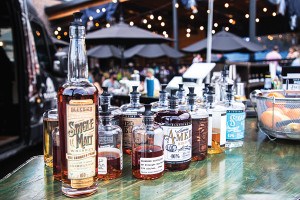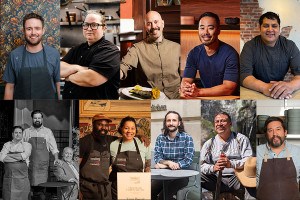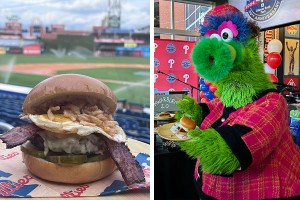The Time Machine: Jansen Reviewed
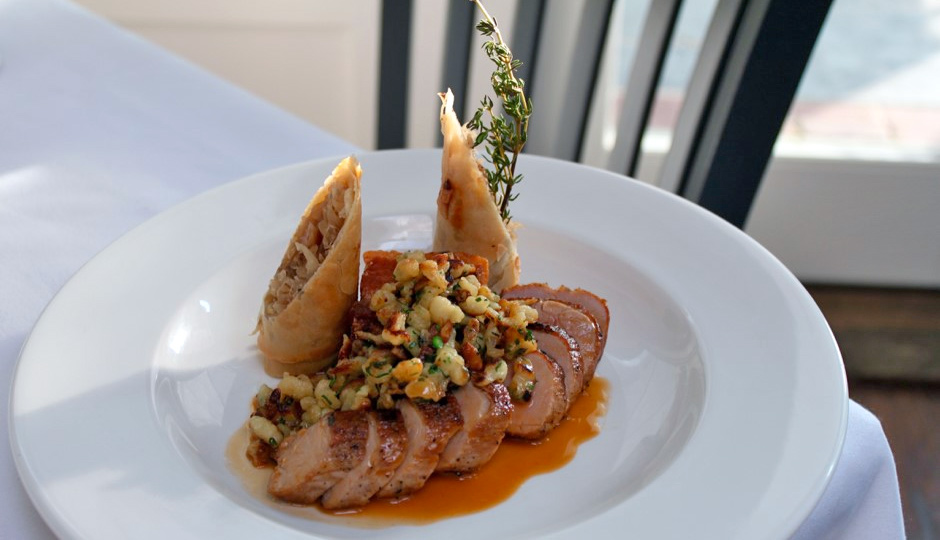
A soaring plate at Jansen in Mount Airy | Photo by Emily Teel
My wife, Laura, hated Jansen as soon as she walked through the door.
To be fair, she actually hated it before she walked through the door. She’d looked at the menu online, with its photos of the dishes available—shellfish sauces, slouching ring-molded tartares with sprigs of thyme poking up like tiny trees, food stacked or clenched tight like fists amid the vast white space of plates doodled with sauce)—and asked why we were doing this.
“I’ve eaten enough country-club food in my life, Jay. Why would I want more?”
And I trotted out all the usual reasons—because this was new, because it was different, because chef David Jansen is (or had been) a big deal seeing as he ran the legendary kitchen at Fountain for a decade as chef de cuisine, then left the kitchen for years (an extended vacation, to be with his family) only to come back, suddenly, six years later in Mount Airy with this eponymous restaurant, where he was now poaching fish and frying goat cheese and twirling plates of printanière-style pappardelle for the neighbors and his friends in a room so white that it made your eyes ache just to look at it.
Then, “It’s just the next one on my list,” I said, but that was a lie.
The truth was, I couldn’t wait to go. For me, Jansen looked like going home again. It was a time machine, poised to take me back to some of the best days of my life.
In the late ’80s, I shuffled pizzas in big ovens, broke the ancient industrial dishwasher I’d been told to attend to on my first day of work (15 years old and barely smart enough to tie my own apron on), learned how to scratch-make red, white and brown sauces and flip a perfect omelet one-handed.
In the ’90s, I was a mercenary. Thirty jobs in 10 years, give or take, filling holes on the lines of French, Italian and American restaurants. I made 10,000 bowls of mussels in white wine beurre blanc. Pushed chips of frozen butter and shaved black truffles beneath the skin of 10,000 roasting chickens.
By ’98, ’99, 2000, I was in bistros and hotel restaurants doing schizophrenic French/Californian menus lifted wholesale from Jacques Pepin and Chez Panisse. New Americanism was still battling it out then with the fading embers of French classicism in the places I lived and worked, and the vertical plating of Alfred Portale and Gotham was still very much in vogue. So I made twisted sculptures of butter-poached lobster tails that rose eight inches high, and fanned slices of pork roulade stuffed with mushroom duxelles before napping the plate with reduced Russian River pinot noir and garnishing with that same vertical Christmas tree of thyme that David Jansen used like a flag to mark his turf when he poked it into a fried potato croquette on the opening-day menu at Jansen.
Okay, I actually used rosemary, which is a little less classy, but the intent and effect are the same. That habit of verticality. The urge to give food a clean frame and the drama of height that, to a certain generation of cooks and chefs, screams siren-loud of a certain time and place along the developmental spectrum of American cuisine. A simpler and more innocent time when all most of us knew how to do was steal and run endless, looping riffs on dishes we’d already cooked a million times. Before fluid gels and reverse-sphericalization. Before modernism and the (flawed) notion that every schoolboy cook is a budding Thomas Keller whose genius must be coddled and allowed to flourish in tasting menus and televised cooking contests. Before tweezers.
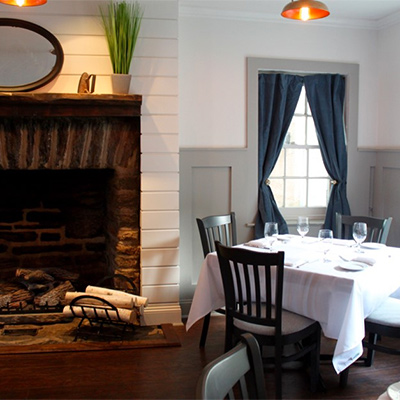
The interior at Mount Airy’s Jansen | Photo by Emily Teel
David Jansen has, apparently, never left that place. And to me, that’s awesome, because someone has to stay behind to defend that turf—to labor on as a disciple of a cuisine that was vanishing from the scene even before he did.
And so his kitchen does a beet carpaccio that’s just as acerbic as the beet carpaccios made before everyone’s beets came pickled or sous-vided or grilled like tiny steaks. He serves them quartered, thick-cut and cold, surrounding a mesclun salad dressed in a citrus vinaigrette and topped with a round of walnut-crusted fried goat cheese, in a perfect reproduction of California cuisine’s most enduring contribution to our American canon. They do salade de Lyonnaise that’s like the billion salades de Lyonnaise that have come before it—not modernized, not deconstructed, not jazzed-up or made with nettles and dandelion as some kind of political statement against Big Frisée, but just there. Bitter frisée and its crunch in counterpoint to the warm smoothness of poached egg, the salt kick of lardons, the sweet/sour top note of sherry vinegar like a dog whistle to appetite.
The menu is a page in its entirety, one side only. Just a handful of apps, followed by a handful of mains without any hedging. No tasting menu, bar menu, small plates, snacks. And that isn’t laziness or a lack of imagination, but confidence. This is a kitchen that has made choices: this, not that; fried soft-shells now over the crabcake that was on the menu earlier (floored with sauce Américaine, which I haven’t seen on a menu since maybe those sky-reaching lobsters I cooked 15 years ago); a purple-red summer tomato soup poured (tableside, of course) over a crouton, replacing spring’s smooth, rich sweet pea soup with chicken confit and truffle essence. This is the way we all ate dinner until recently—another deliberate choice by Jansen to ignore today for yesterday’s charms—and it’s brave, because fewer dishes means fewer places to hide. It means that everything has to be perfect.
And so much of what Jansen does is—if by perfect you mean museum-quality replicas of dishes 15 years gone from the boards and tables of American restaurants that have substituted innovation for technique. On a Saturday night, Laura and I are seated in that low-ceilinged white room with white banquette seats and white tablecloths and a back door opening onto a patio with a white canvas tent roof and white twinkle lights in the trees. We drink cucumber gin with lime (too full of pulp), and I eat grilled shrimp curled around each other in an embrace, balanced atop a wide, floppy, tender truffle ravioli in a pale pinkish-brown shellfish reduction that is so delicious, rich and deeply flavored that I wish I could have it as a shot. The reduction is spotted with green peas and swirled with the creamy, green-flecked butter sauce in which they were cooked until it all comes together like the blobs in a lava lamp. Pop art made into dinner.
Saturday’s turbot is overcooked, too solid and with no life left in it, but Jansen has had better fish on his menu done in the “chinoiserie” style, which is essentially a Frenchman’s way of saying Asian fusion without having to admit there is any cuisine on Earth worth naming that isn’t French. Thus, it’s plated over black forbidden rice in a thin broth that tastes of acid and ginger, and kept company by a beggar’s purse dumpling, deep-fried, crispy, and stuffed with finely chopped seafood and herbs. When I find bones, I stack them politely on the side of my plate alongside the pinwheels of preserved lemon. The dumpling I finish in two bites, before it goes limp in the broth.
Across the room, the servers dote on a table of 30-somethings, wine-drunk and loud but beloved regardless because they’re the young people in the room tonight. At the table next to ours, the conversation is two hours on how bad the service is (it isn’t at all), kids these days, and the Allied invasion of Holland, with only a short break to complain about the unrecognizable modernity of tempura soft-shell crabs in a sauce of curry and coriander, crowned with a proud flag of dill.
And this is the challenge with Jansen—the tightrope he and his crew must walk. In order to like the place the way I do, you have to enter into it with a love of everything that came before this culinary moment we find ourselves in today. You don’t have to understand the rarity of sauce Américaine (and why it went away) or the socio-architectural inspirations behind vertical plating (and what replaced it), but you do have to get that today has a past. That there were steps that brought us to this moment. And that they can be re-explored with sincerity.
What Jansen has built in Mount Airy is a gastronomic time machine—not some sly, sardonic wink-and-a-nod send-up of wine coolers and salad bars (read: Juniper Commons), but something more pure and almost hokey in its absolutely earnest Saturday Evening Post-ish embrace of culinary nostalgia. His restaurant is an ode to the style, the design and the dishes that made him as a chef, and he cooks them with zero irony.
Which, today, might be the most revolutionary thing a chef can do.
2 stars – Come if you’re in the neighborhood
Jansen [Foobooz]
